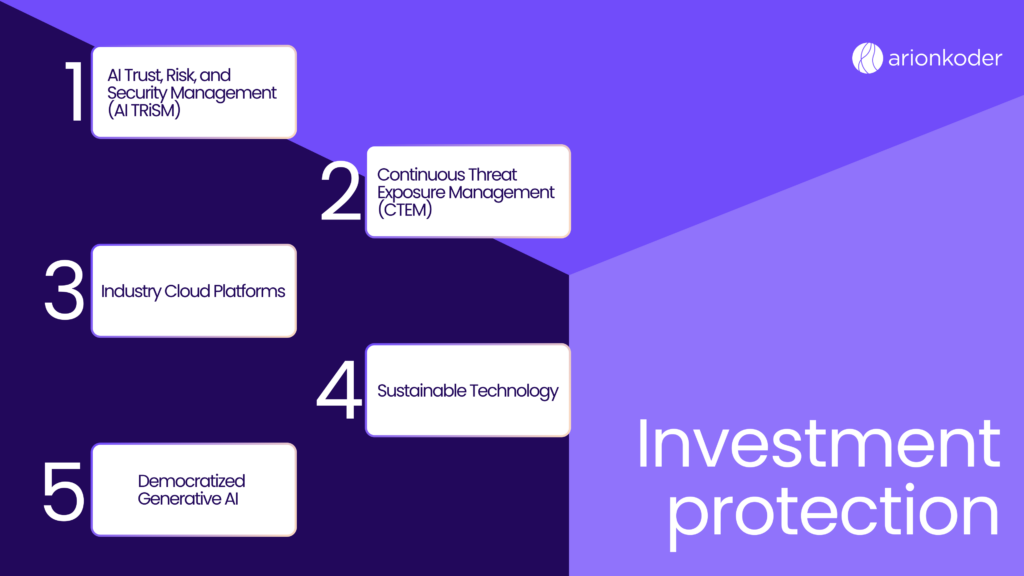AI isn’t just knocking on our door – it’s already inside, flourishing, and evolving fast enough to revolutionize every vertical. This exciting transformation demands that we take proactive steps to thrive in this AI-powered world, including building trust in our AI solutions, making our operations more sustainable, finding the right tech tools, and boosting our productivity.
Gartner has identified AI niches in their top 10 strategic technology trends for 2024, that not only are impacting in building and safeguarding organizations, but also generating remarkable value. These fall into three key categories: Investment Protection, AI Building, and Value Delivery. Let’s take a closer look at the first category, Investment Protection, which focuses on securing the benefits from past and future strategic technology decisions to make them last.

- AI Trust, Risk, and Security Management (AI TRiSM)
TRiSM brings together the powers of anomaly detection, data protection, and application security to ensure our AI models are reliable and trustworthy. It’s all about fairness, transparency, and data protection, which, in turn, supercharges the accuracy of AI applications. According to Gartner, companies embracing TRiSM by 2026 could eliminate up to a whopping 80% of inaccurate and unauthorized data in their apps. To get started in this field, they recommend setting up dedicated teams to manage these specific efforts, working across organizations to manage the right toolsets while defining methodologies that record and approve access to AI models. In Arionkoder, we have previously assembled teams specialized in MLOps, data governance and AI implementation for companies seeking to start traversing this path in a capital-efficient way.
- Continuous Threat Exposure Management (CTEM)
In a world filled with uninterrupted menaces, CTEM aims to systematize cybersecurity priorities. From scoping to discovery, prioritization, validation and mobilization, this approach considers both diagnosis and actions to detect threats, investigate and respond to them, as well as adjust security postures. Anomaly detection algorithms play a substantial role in this matter, as they are able to identify deviations from normal behavior without requiring to know how those deviations are produced or might look like.
By 2026, organizations making cybersecurity decisions with a CTEM approach will experience a two-thirds reduction in security breaches.
- Industry Cloud Platforms
These platforms combine SaaS, PaaS and IaaS services in a composable way to cater to specific industries, giving companies the flexibility to respond to disruptions and build resilience. Cloud platforms are a reliable alternative to bypass risks associated with on-premise computing, mostly related to 24/7 availability, resilience to failures, etc. At Arionkoder we exploit both sides of the coin, depending on our clients’ requirements. In healthcare applications, for example, it is fundamental to keep data governance on-premises to avoid security concerns. In more general industries, however, cloud platforms are the best alternative to avoid huge investments in infrastructure. By 2027, more than half of enterprises are expected to harness industry cloud platforms, up from just 15% in 2023.
- Sustainable Technology
To support long-term environmental, social, and governance rights, a framework of digital solutions can be leveraged. Environmental technologies mitigate risks derived from the natural world, social technologies focus on enabling well-being, prosperity and human rights, and governance technologies strengthen business conduct and oversight. By 2027, a quarter of CIOs may have their bonuses linked to their impact on sustainable technology. And AI comes to play a fundamental role here: ML models can automate tasks that might otherwise require mobility, for example, but also find more energy-efficient and sustainable ways to produce the same results.
- Democratized Generative AI
The ability to create net new content, and the spread of its availability, will democratize access to information and skills in a way that enables the automation of thousands of tasks. Business users will access all kinds of knowledge and technical skills, and technology will be improved as a result of open-source and cloud initiatives, all of this in a regulated, responsible setting marked by governance practices. By 2026, over 80% of enterprises will have used generative AI APIs, models and/or deployed generative AI-enabled applications in production environments, an impressive jump from less than 5% today.
These are just a few of the exciting AI trends that lie ahead, ready to protect and empower your organization. At Arionkoder, our AI Labs are geared up to help you ride these waves and achieve the impossible. Reach out to us at [email protected], and let’s tackle your challenges and explore our solutions together! Stay tuned for more insights on AI trends: next time, we’ll cover trends around AI Building.
